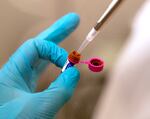
DNA evidence is processed at Washington State Patrol’s Crime & Forensic Laboratory in Vancouver, Wash., March 14, 2025.
Kristyna Wentz-Graff / OPB
In 1988, Deborah Atrops was reported missing to police by her husband Robert.
When she was found dead, police quickly honed in on her husband as the prime suspect, but without enough evidence to charge him, the case went cold.
Until more than three decades later, when Washington County prosecutors declared they’d finally solved the case, and charged Robert Atrops with Deborah Atrops’ murder — thanks, in part, to DNA.
Since its introduction, DNA has been considered the “gold standard” of evidence. And advances in DNA testing over the years have sometimes provided the opportunity for a second look at decades-old cases like this one.
But DNA evidence isn’t always as simple as it seems on television. Sometimes what it tells us isn’t so clear.
OPB legal affairs reporter Conrad Wilson and public safety and health editor Michelle Wiley have been closely following the Atrops case for months, and join us to explain.
Listen to all episodes of The Evergreen podcast here.